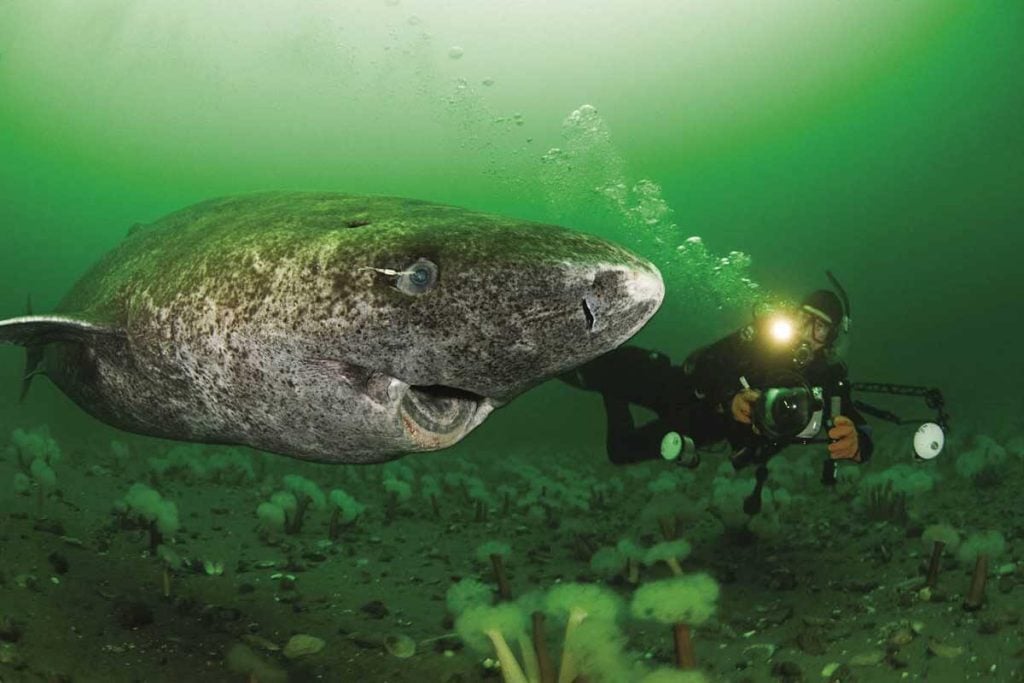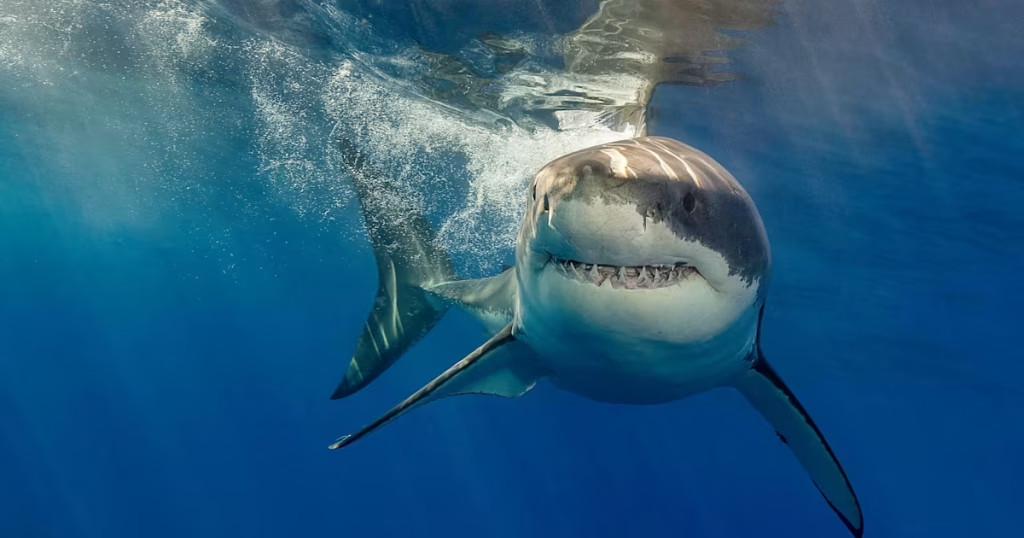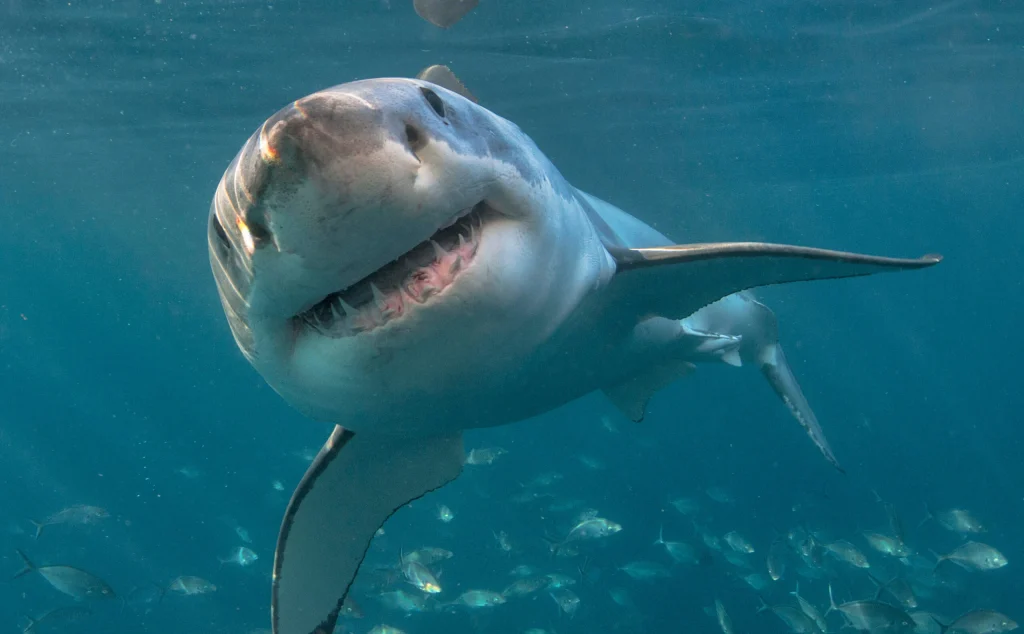Movies like Jaws have led people to stereotype sharks as terrifying, human-killing machines that chase after us with their razor-sharp teeth as often as possible. More recently, shark defenders and eco-warriors have been correcting these misconceptions, like the reality that sharks don’t actually attack humans all that often. Here are 10 other surprising shark facts that you probably never knew about these majestic creatures of the sea.
1. Greenland sharks almost always go blind
These formidable creatures swim the ice-cold North Atlantic and Arctic Oceans. They’re often viewed as clumsy and less adept than other sharks, and part of that is because most of them go 100% blind at some point in adulthood. This is because parasitic crustaceans known as Ommatokoita elongata often embed themselves in the eyes of these sharks, where they eat away at the animal’s corneas over the years until they can only vaguely distinguish between light and darkness. Fortunately, their sense of smell helps guide them!

2. Swell sharks can double in size
This species of shark isn’t known for being big or aggressive. Instead, they’re known for an unusual strategy to defend themselves. They sneak into a rocky underwater crevice and swallow immense amounts of water until they double in size. This enables them to get wedged between rocks, making it harder for predators to access and attack them.
3. Great white sharks may have led to the megalodon’s extinction
2.6 million years ago, the megalodon went extinct. At approximately 60 feet and 110,000 pounds, it was and still is the largest shark ever to have roamed the oceans. Despite being much larger and heavier than the great white shark, the megalodon’s extinction is partially due to the dietary competition between the two species, who are thought to have competed for the same prey. Ultimately, the meg was outcompeted.

4. Some shark species lay eggs shaped like spirals
Not all sharks give birth to live pups. Some lay eggs, and they can come in various shapes, including a spiral! The spiral shape allows the mother to pick up the egg, screwing it into crevices and rocks to anchor it securely. The Port Jackson shark is known for this. So is the crested hornshark, which also has tightly spiraled tendrils that anchor in algae or seaweed.

5. Cookiecutter sharks have chomped into submarines
This dates back to the 1970s, when the US Navy began to notice holes in the rubber covers of their submarine domes. They thought it was from their enemies, but investigations showed that they were bites from the cookiecutter shark. Despite being tiny (the largest ones are under two feet), they have the most impressive teeth-to-body ratio of all sharks. They suction their lips onto prey (or submarines), lock into place, and twist their bodies to take out a chunk of their prey, leaving this unique hole behind.
6. Sharks don’t have bones
Yup, that’s right, no bones at all. Shark skeletons are actually made of cartilage, the same material that human ears and noses are made out of. Their teeth are the only rigid part of them. Cartilage is lighter and more flexible than bones, allowing sharks to swim faster than other fish. This also lets them open their mouth wider, since their top jaw isn’t fused to their skulls. Calcium salts, which are plentiful in their diet, help keep their spine, skull, and jaws strong.
7. Some shark species can flip their stomachs inside out
Although sharks are known for having super acidic stomachs that can break down most substances, they can’t digest everything. Some species deal with this by turning their stomachs inside out, aka vomiting their stomachs. Otherwise known as gastric eversion, this process involves a shark expelling the stomach from its mouth, which lets them rinse it out in the water. Then they suck it back in. They might also do this as a stress response or to make space for tastier food.
8. A shark’s skin is made out of tiny teeth
While most people fear the teeth inside a shark’s mouth, their skin is even more shocking. Under a microscope, it looks like it’s coated with tons of small, razor-sharp teeth— and it is! These scales are made out of dentine, the same material their teeth are coated with. They’re called dermal denticles, and while they feel smooth when rubbed in one direction, the other feels jagged because of the tooth-like surface, which helps them swim faster and offers an additional layer of protection.
9. Sharks have existed longer than trees
These prehistoric creatures have been around before dinosaurs and are referred to as living fossils since they’ve survived several extinction events. They even outdate trees. In 2019, fossilized trees dating back 386 million years were discovered. However, sharks date back 450 million years with the discovery of shark-like scales. Shark-like teeth date back 410 million years, which is still a lot longer than those trees have been alive.

10. One shark can walk on land
This shark species is a lot less scary than it sounds. The epaulette shark is only around 3 feet long and doesn’t look scary. They live in the waters surrounding Papua New Guinea and Australia. When the epaulette shark is beached, it slows its breath and heart rate to save oxygen reserves. Then, its pectoral and pelvic fins act as legs that help propel it forward until it’s able to slowly shuffle back to the water.
